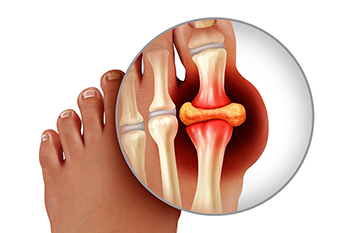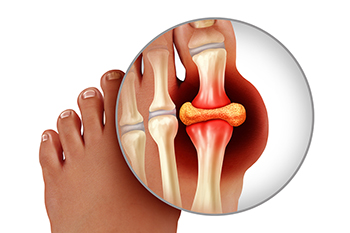Pediatric Gout

Gout is a type of inflammatory arthritis where too much uric acid in the body causes sharp crystals to form in joints. Uric acid forms when the body breaks down chemical compounds called purines. Purines are naturally produced by the body, and they also come from the foods we eat. Foods higher in purines include animal organ products, certain seafood, soda with fructose, and alcohol. Gout can cause pain, redness, and swelling in and around the joints of the feet. It is particularly common in the big toe. While gout typically affects adults, it can also happen to children. Pediatric gout is rare, more common in males, and is usually linked to underlying medical conditions, including obesity, Down syndrome, and congenital heart disease. If your child is complaining of big toe pain, it is strongly suggested that you take them to a podiatrist for a proper diagnosis and treatment.
Gout is a painful condition that can be treated. If you are seeking treatment, contact one of our podiatrists from Family Foot & Ankle Centers. Our doctors will treat your foot and ankle needs.
What Is Gout?
Gout is a form of arthritis that is characterized by sudden, severe attacks of pain, redness, and tenderness in the joints. The condition usually affects the joint at the base of the big toe. A gout attack can occur at any random time, such as the middle of the night while you are asleep.
Symptoms
- Intense Joint Pain – Usually around the large joint of your big toe, and it most severe within the first four to twelve hours
- Lingering Discomfort – Joint discomfort may last from a few days to a few weeks
- Inflammation and Redness -Affected joints may become swollen, tender, warm and red
- Limited Range of Motion – May experience a decrease in joint mobility
Risk Factors
- Genetics – If family members have gout, you’re more likely to have it
- Medications – Diuretic medications can raise uric acid levels
- Gender/Age – Gout is more common in men until the age of 60. It is believed that estrogen protects women until that point
- Diet – Eating red meat and shellfish increases your risk
- Alcohol – Having more than two alcoholic drinks per day increases your risk
- Obesity – Obese people are at a higher risk for gout
Prior to visiting your podiatrist to receive treatment for gout, there are a few things you should do beforehand. If you have gout you should write down your symptoms–including when they started and how often you experience them, important medical information you may have, and any questions you may have. Writing down these three things will help your podiatrist in assessing your specific situation so that he or she may provide the best route of treatment for you.
If you have any questions, please feel free to contact one of our offices located in Corsicana, Ennis, and Waxahachie, TX . We offer the newest diagnostic and treatment technologies for all your foot care needs.
The information provided in this article is not meant to be medical advice and is for educational purposes only. If you would like to learn more about topics related to podiatry, feel free to contact Family Foot & Ankle Centers by clicking here or calling 972-597-4132 to reach our Waxahachie office, 903-872-9910 to reach our Corsicana office, or 972-875-3668 to reach our Ennis office.



